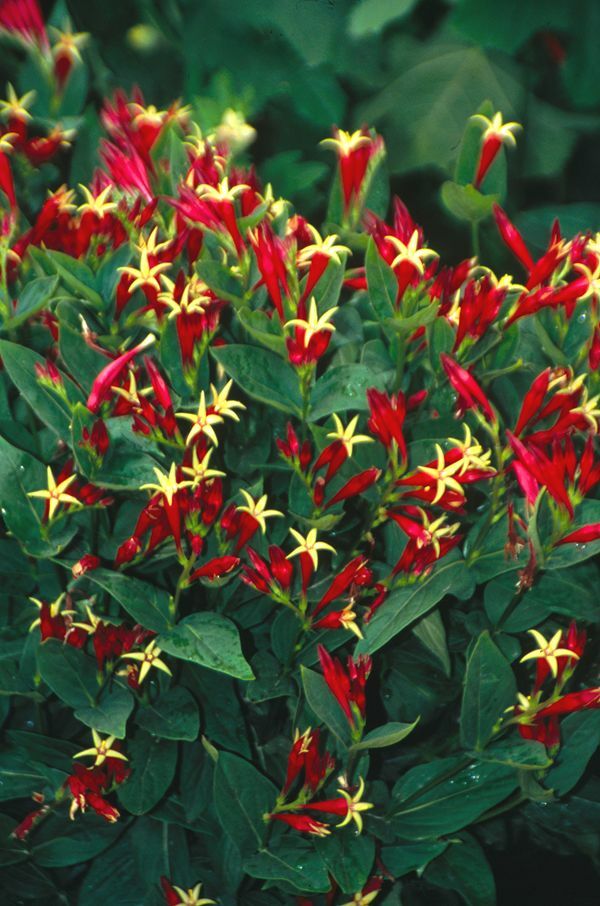Spigelia marilandica is another of those great southeast native plants (NJ south to Florida and west to Texas) that few people have grown or even heard about. In the wild, I usually see Spigelia growing on deeply wooded slopes, where its appearance is interesting but spindly, with a sparse and far from impressive floral show.
Spigelia marilandica
In the garden, however, it's a different matter. When grown in light filtered shade or a few hours of sun, especially in the morning, Spigelia marilandica makes a truly stunning perennial. Spigelia emerges in spring and quickly forms a tight, 20" tall patch of upright stems, each ending in a terminal spray of red, tubular, upfacing, star-shaped flowers that open at the tip to reveal a butter-yellow center. A well-grown clump of spigelia marilandica can have over 75 flowering stalks at once. As with most tubular red flowers, spigelia is a great way to draw hummingbirds to the garden. Spigelia marilandica begins flowering for us in mid-spring but, if the old flowers are removed, your clump will flower again into the summer.
Europeans realize the value of our native Spigelia marilandica much more than those of us who live in its own back yard. In the early 1990s, we sold and shipped several dozen plants to the famed Hillier Nurseries in the UK and nearly a decade later I had the occasion to visit Hillier where I found greenhouses filled with spigelias propagated from our original shipment. Not only were the plants prospering, but their annual spigelia sales top 2 million plants...more than have sold in the history of their cultivation in the US. Propagation has proven easy via cuttings, although spigelia plants must be rooted early in the season or they won't form an underground growth bud and, consequently, won’t return for the subsequent season.
Spigelia marilandica also has a lovely sister, Spigelia gentianoides...a smaller, but insanely floriferous plant with amazing pink flowers. Unfortunately, Spigelia gentianoides isn't plentiful in the wild, so the Feds declared it an Endangered Species. This designation and accompanying restrictions ensure it won't get propagated and sold commercially, which would be the best way for it remain around as the climate continues to change. In the meantime, you can see its oversized portrait on the side of U-Haul rental vans that feature its native state, Alabama.
Despite all the horticultural love from the EU community, Spigelia is a plant in familial flux...tossed around various plant families by uncaring taxonomists for centuries. For much of its life, spigelia has lived with the Loganiaceae family where it currently resides, but many of its former siblings, like butterfly bushes, have been recently given up to other plant families for adoption...so spigelia is now relegated to attending family reunions with the likes of little-known genera such as Antonia, Bonyunia, Mitrasacme, and Usteria.
The common name Indian Pink refers to its medicinal properties thanks to the alkaloid spigiline. The dried roots are used as a hallucinogen, although death is an unfortunate side effect of improper use. Indian Pink is also an effective anthelmintic...a fancy, polite company word for a roundworm and tapeworm de-wormer. I truly hope you seek out this great native perennial, but for its horticultural purposes only.

